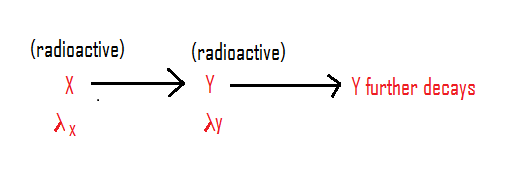
A radioactive substance X decays into another radioactive substance Y. initially, the only X was present. Also, ${\lambda _x}$ and ${\lambda _y}$ are the disintegration constants of X and Y. ${N_y}$ will be maximum when (${N_y}$ is an atom of Y)
(A) $\dfrac{{{N_y}}}{{{N_x} - {N_y}}} = \dfrac{{{\lambda _y}}}{{{\lambda _x} - {\lambda _y}}}$
(B) $\dfrac{{{N_x}}}{{{N_x} - {N_y}}} = \dfrac{{{\lambda _x}}}{{{\lambda _x} - {\lambda _y}}}$
(C) ${N_y}{\lambda _y} = {N_x}{\lambda _x}$
(D) ${N_y}{\lambda _x} = {N_x}{\lambda _y}$
Answer
577.5k+ views
Hint: A radioactive substance is unstable and decays naturally giving out alpha-particle, beta-particle or gamma-rays. In a radioactive decay lot of energy is released. Polonium is a naturally occurring element that releases a huge amount of energy. A radioactive element continuously decays until it gets converted into a stable element.
Formula used:
$\lambda = - \dfrac{1}{{N(t)}}\dfrac{{dN}}{{dt}}$ ;
This is the formula for decay per unit time. Where,$\lambda $ is a disintegration constant and $N$ is the number of nuclei present. Here, the negative sign shows the decrease in the number of nuclei.
Complete step by step solution:
According to the question, radioactive nuclei $X$ disintegrates into another radioactive nucleus $Y$ and then $Y$ decays either into a stable of unstable nuclei, it’s not given and we need not bother about it as well.

It is given in the question, ${\lambda _x}$ and ${\lambda _y}$ are the disintegration constants of X and Y respectively. The disintegration constant tells the fractional change in the number of atoms per unit time. Mass can neither be converted nor be destroyed, therefore the rate of formation of Y is proportional to the remaining atoms of $X$.
Now, let us use the formula $\lambda = - \dfrac{1}{{N(t)}}\dfrac{{dN}}{{dt}}$and write the rate of formation of $Y$.
$\dfrac{{d{N_y}}}{{dt}} = {\lambda _x}{N_x} - {\lambda _y}{N_y}$
Now, it is asked to find the maximum value of ${N_y}$.
We know that to find the maximum value of any quantity we equate its first derivative to zero.
So we equate $\dfrac{{d{N_y}}}{{dt}}$ equal to zero and we get the following.
$\dfrac{{d{N_y}}}{{dt}} = {\lambda _x}{N_x} - {\lambda _y}{N_y} = 0$
On simplifying we get.
${\lambda _x}{N_x} = {\lambda _y}{N_y}$
$\therefore $ Hence, option (C) ${\lambda _x}{N_x} = {\lambda _y}{N_y}$ is the correct option.
Note:
Radioactive decay occurs in unstable nuclei whose binding energy is not enough to hold the neutrons and protons together.
The reason behind it is either excess of neutrons or protons in the nucleus.
Alpha decay, beta decay, and gamma decay are the three types of decay.
The rate of disintegration is a substance that is proportional to the number of atoms per unit time.
Formula used:
$\lambda = - \dfrac{1}{{N(t)}}\dfrac{{dN}}{{dt}}$ ;
This is the formula for decay per unit time. Where,$\lambda $ is a disintegration constant and $N$ is the number of nuclei present. Here, the negative sign shows the decrease in the number of nuclei.
Complete step by step solution:
According to the question, radioactive nuclei $X$ disintegrates into another radioactive nucleus $Y$ and then $Y$ decays either into a stable of unstable nuclei, it’s not given and we need not bother about it as well.

It is given in the question, ${\lambda _x}$ and ${\lambda _y}$ are the disintegration constants of X and Y respectively. The disintegration constant tells the fractional change in the number of atoms per unit time. Mass can neither be converted nor be destroyed, therefore the rate of formation of Y is proportional to the remaining atoms of $X$.
Now, let us use the formula $\lambda = - \dfrac{1}{{N(t)}}\dfrac{{dN}}{{dt}}$and write the rate of formation of $Y$.
$\dfrac{{d{N_y}}}{{dt}} = {\lambda _x}{N_x} - {\lambda _y}{N_y}$
Now, it is asked to find the maximum value of ${N_y}$.
We know that to find the maximum value of any quantity we equate its first derivative to zero.
So we equate $\dfrac{{d{N_y}}}{{dt}}$ equal to zero and we get the following.
$\dfrac{{d{N_y}}}{{dt}} = {\lambda _x}{N_x} - {\lambda _y}{N_y} = 0$
On simplifying we get.
${\lambda _x}{N_x} = {\lambda _y}{N_y}$
$\therefore $ Hence, option (C) ${\lambda _x}{N_x} = {\lambda _y}{N_y}$ is the correct option.
Note:
Radioactive decay occurs in unstable nuclei whose binding energy is not enough to hold the neutrons and protons together.
The reason behind it is either excess of neutrons or protons in the nucleus.
Alpha decay, beta decay, and gamma decay are the three types of decay.
The rate of disintegration is a substance that is proportional to the number of atoms per unit time.
Recently Updated Pages
A man running at a speed 5 ms is viewed in the side class 12 physics CBSE

The number of solutions in x in 02pi for which sqrt class 12 maths CBSE

State and explain Hardy Weinbergs Principle class 12 biology CBSE

Write any two methods of preparation of phenol Give class 12 chemistry CBSE

Which of the following statements is wrong a Amnion class 12 biology CBSE

Differentiate between action potential and resting class 12 biology CBSE

Trending doubts
What are the major means of transport Explain each class 12 social science CBSE

Which are the Top 10 Largest Countries of the World?

Draw a labelled sketch of the human eye class 12 physics CBSE

Explain sex determination in humans with line diag class 12 biology CBSE

Explain sex determination in humans with the help of class 12 biology CBSE

Differentiate between homogeneous and heterogeneous class 12 chemistry CBSE




